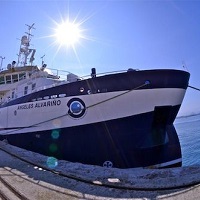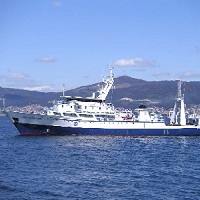Keyword
Moored instrument depth
15 record(s)
Type of resources
Categories
Topics
INSPIRE themes
Keywords
Contact for the resource
Provided by
Years
Formats
Status
-

The objective of the DOS MARES project is twofold. First, we aim at understanding the effects of the atmospheric teleconnections between the Cantabrian Sea and the north-western Mediterranean Sea, and their impacts on the deep ecosystem, both pelagic and benthic. Second, we want to know in which way the transfer of the signal from the external forcings towards the deep ecosystem controls the community structure and the population dynamics. Thus, in March 2012 we deployed 6 mooring lines equipped with sediment traps and currentmeters in the Avilés and Gaviera canyons and the slope. In September 2012 the moorings were successfully recovered and redeployed again, and during this cruise DOSMARES BIOCANT3 they have been finally recovered and the 1-year monitoring effort finalised. In addition, CTD profiling has been performed to characterise the biological and physical structure of the water column (including the acquisition of discrete water samples), multicorers have been obtained to characterise the geochemical properties of surface sediments, and a multinet used to obtain macro- and meso-zooplankton community structure. Overall, data will allow to characterize the external forcings and abiotic conditions in the Cantabrian Sea, and thus establish the links between abiotic conditions, populations and pelagic and benthopelagic resources.
-

The objective of the DOS MARES project is twofold. First, we aim at understanding the effects of the atmospheric teleconnections between the Cantabrian Sea and the north-western Mediterranean Sea, and their impacts on the deep ecosystem, both pelagic and benthic. Second, we want to know in which way the transfer of the signal from the external forcings towards the deep ecosystem controls the community structure and the population dynamics. Thus, in March 2012 we deployed 6 mooring lines equipped with sediment traps and currentmeters in the Avilés and Gaviera canyons and the slope. In September 2012 the moorings were successfully recovered and redeployed again, and during this cruise DOSMARES BIOCANT3 they have been finally recovered and the 1-year monitoring effort finalised. In addition, CTD profiling has been performed to characterise the biological and physical structure of the water column (including the acquisition of discrete water samples), multicorers have been obtained to characterise the geochemical properties of surface sediments, and a multinet used to obtain macro- and meso-zooplankton community structure. Overall, data will allow to characterize the external forcings and abiotic conditions in the Cantabrian Sea, and thus establish the links between abiotic conditions, populations and pelagic and benthopelagic resources.
-

Long term time series monitoring in 3 standard sections: Santander, Gijón and Cudillero to study the hydrographical and biological variability and tendencies in the water masses, the timing of any pronounced shift observed on them as well as the search of their causes and their biogeochemical consequences. AGL buoy sensors calibrations. The cruise included the servicing of a mooring located north of Peñas Cape. Previous deployment was made on May 2015. The line was provided with three single-point current-meters and a 75 kHz ADCP. New recovery is expected by October-November.
-

The NUREIEV2 cruise targets the main objective of testing the hypothesis that sea storms are the main trigger for the transfer of matter and energy, including pollutants and litter, from the coastal to the deep ocean in the SE of Spain (36º20’N to 37º36’N and 2º40’W to 0º40’W). A dedicated strategy was performed during the NUREIEV2 cruise to achieve the objective including: 1) the collection of sediment cores (multicores) in the vicinity of the mine tailings deposit near the Portman Bay 2) the recovery and redeployment of mooring lines with automated sediment traps and currentmeters to monitor particle fluxes (including pollutants released from the mine tailings deposit) and near bottom oceanographic parameters (current speed and directions, temperature, transmissivity), 3) the profiling of the water column (by means of a CTD) to study physico-chemical characteristics of the water column, 4) the collection of floating debris including microplastics from surface waters 5) and the high resolution swath mapping and TOPAS profiling to investigate seafloor features.
-

The leg 1 of the NUREIEV 3 oceanographic cruise took place from 22 to 30 April 2016. The area of work has located on the continental margin of the SE of Iberian Peninsula, off the coast of Murcia and Almeria, with reference coordinates from 36º20'N to 37º36'N and 2º40'W to 0º40'W. The tasks performed consisted of: • Bathymetric mapping with multibeam echosounder for seabed mapping, from inner shelf to upper slope (50 to 1500 m depth). • Geophysical works with TOPAS, very high resolution seismic profiles, to characterize the sedimentary cover of the study area. • Recovery of 5 mooring lines, instrumented for the continuous monitoring of the hydrological (water masses) and sediment (particle fluxes) dynamics from the last cruise in September 2015. Each mooring line is composed by one current meter for measuring temperature, turbidity, velocity and direction of currents and one sediment trap for sampling sinking particles. In addition, each mooring is equipped with an acoustic release for recovery and with suitable buoyancy. Monitoring with instrumented mooring lines has covered an annual cycle, in two phases of 6 months each one. • CTD profiling and water sampling. Profiles have been made in each of the submarine canyons monitored for measuring physical and chemical variables of water column (temperature, salinity, turbidity, oxygen concentration and chlorophyll) and calibration of instruments of mooring lines. • Performing surface sampling of floating microplastics by neuston net. • Sampling of surface sediments by multicorer.
-

ISLAND is a research cruise that will address the above issues through the following 3 specific objectives: a) To explore how the NW Sicilian canyons evolved during the Late Quaternary (differences in style, frequencies and intensity of sedimentary flows, possible differences in forcing mechanisms) and to assess which canyon(s) is/are more “active” in the present-day conditions and why. b) To establish whether canyons displaying different morphologies and controlled by different processes may be characterized by differences in the spatial distribution and variability of benthic biomass and biodiversity (are the most active canyons always the most biodiverse?). c) To explore the role of bottom trawling fishery in shaping the morphology and governing the presentday dynamics of submarine canyons and eventually assess its impact in altering canyon biodiversity (is trawling activity affecting the natural canyon seascapes and sedimentary dynamics, inducing a change in biodiversity?).
-

To i nstall 6 moorings in the Avilés Canyon region. To conduct biological and geological sampling in the area, including both plankton and benthos.
-

To recovery 6 moorings in the Avilés Canyon region. To conduct biological and geological sampling in the area, including both plankton and benthos.
-

The EU funded MIDAS RTD project (7th FP, gran agreement 603418) overarching objective is to determine the impact of deep-sea mining on deep marine ecosystems. To investigate the behaviour and the effects of heavy metal rich resuspended sediment plumes over benthic organisms and ecosystems, the University of Barcelona coordinates a plume generation and monitoring experiment in the bay of Portman, SE of Spain, where millions of tones of metal rich mine tails from onshore mines were dumped from 1957 to 1990. Prior to the seafloor disturbance experiment to generate the plumes, a careful mapping of the study area, and in particular of the area covered by the mine tails deposit was carried out. Two vessels are used for the disturbance experiment. The first vessel generates the plumes by bottom trawling, while the second one monitors the plume evolution through time with a variety of sensors, including acoustics. Moorings with sediment traps, current-meters, mussel ropes and baited traps are deployed in and around the seafloor area disturbed by the trawler.
-

The cruise RadProf201209 is part of the timeseries program from the Spanish Institute of Oceanography (IEO) following international strategies for ocean climate monitoring (CLIVAR, GOOS etc). It covers a hydrographical section westwards of Cape Finisterre in Northwest Spain along the 43ºN latitude, extending c.a. 250 nm into the western Iberia basin. The sampling includes hydrography, current velocity fields and water samples collection for biogeopchemical analysis. It is planned the deployment of a mooring line at 43ºN; 11ºW, at a site where current measurements timeseries exist. RadProf201209 adds specific sampling of biogeochemical properties, organic matter and plankton in alliance with the research project BIOPROF.
 Catálogo de datos del IEO
Catálogo de datos del IEO